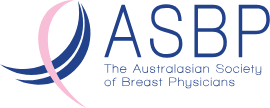Journals and Media
News
ASBP curriculum endorsed by ASBD
The Australasian Society of Breast Physicians is proud to announce that our training curriculum is endorsed by the Australasian Society of Breast Disease.
“Breast Medicine Physicians” now recognised in Queensland
The Queensland Health State Recognised Practice Committee has endorsed the ASBP definition of the “knowledge, abilities and skills which constitute Breast Medicine”. The Fellowship program of the ASBP is recognised by Queensland Health for credentialing of clinical practice in Breast Medicine. To see the full document click here.
Unilateral Axillary Adenopathy in the setting of COVID-19 vaccine
Excerpt: With the recent US Food and Drug Administration (FDA)-approval and rollout of the Pfizer-BioNTech and Moderna COVID-19 vaccines, it is important for radiologists to consider recent COVID-19 vaccination history as a possible differential diagnosis for patients with unilateral axillary adenopathy. Hyperplastic axillary nodes can e seen on sonography after any vaccinations but are more common after a vaccine that evokes a strong immune response, such as the COVID-19 vaccine. As the differential of unilateral axillary adenopathy includes breast malignancy, it is crucial to both thoroughly evaluate the breast for primary malignancy and to elicit history of recent vaccination. As COVID-19 vaccines will soon be available to a larger patient population, radiologists should be familiar with the imaging features of COVID-19 vaccine induced hyperplastic adenopathy and its inclusion in a differential for unilateral axillary adenopathy. Short-term follow-up for unilateral axillary adenopathy in the setting of recent COVID-19 vaccination is an appropriate recommendation, in lieu of immediately performing potentially unnecessary and costly axillary lymph node biopsies.
Imaging Features of Inflammatory Breast Disorders: A Pictorial Essay
Excerpt:
Inflammatory breast disorders include a wide array of underlying causes, ranging from common benign infection, non-infectious inflammation and inflammation resulting from underlying breast malignancy. Because it is at times difficult to distinguish mastitis and breast cancer based on clinical features, awareness of detailed imaging features may be helpful for better management of inflammatory breast disorders. Therefore, this pictorial essay intends to demonstrate radiologic findings of a variety of inflammatory breast disorders, using selected cases with mammography, ultrasound and magnetic resonance images.

Cancer Australia CEO Dr Helen Zorbas about what GPs need to know on testing for ovarian cancer in asymptomatic women
The latest evidence does not support any tests or combination of tests for screening or surveillance of ovarian cancer.
Ovarian cancer has been called a ‘silent killer’, as it tends to either have no symptoms or symptoms that can easily be interpreted as other, less malign health issues. This can make it hard to detect the disease early and provide the best possible chance for patient treatment.
‘Unfortunately, survival rates [of ovarian cancer], although they have improved over the past 20 years, still remain low at 45.7% five-year relative survival,’ Cancer Australia Chief Executive Dr Helen Zorbas told newsGP.
‘So there is a great interest amongst women and health professionals to not miss the disease and diagnose it early.’
To mark Ovarian Cancer Awareness Month, Cancer Australia has released its updated position statement, ‘Testing for ovarian cancer in asymptomatic women’. This represents the statement’s first update in 10 years and incorporates the latest evidence in the field, much of which has been focused on whether there is a feasible option for screening or surveillance testing for ovarian cancer.
‘It was considered important to review the evidence and to provide up-to-date guidance, particularly to GPs who are at the frontline of women who may be concerned about risk of ovarian cancer, or who may be hearing about the disease and want to understand how to be screened for it,’ Dr Zorbas explained.
On the basis of this evidence, the advice in the position statement further underlines that of its 2009 predecessor; however, Dr Zorbas believes this is just as important to publicise as would be the fact of a new test or procedure.
‘I guess it’s regrettable we don’t have a better news story, if you like. But, importantly, they’re very clear recommendations to guide women and health professionals in relation to the lack of evidence to support the use of any particular test or combination of tests to reduce mortality from ovarian cancer,’ Dr Zorbas said.
‘So not as a screening test or an early detection test for women at population risk, or even for women at potentially high risk of ovarian cancer.’

Cancer Australia Chief Executive Dr Helen Zorbas wants to provide GPs with up-to-date, evidence-based recommendations on identifying and testing for ovarian cancer.
Part of the reason such testing for the purposes of surveillance or screening is not feasible is that many current procedures are very invasive.
‘For example, a potential positive finding on one of those tests as a diagnosis for ovarian cancer would require removal of an ovary – surgery so that tissue could be examined,’ Dr Zorbas said.
‘Therefore, there are significant risks associated with such procedures and we would need to have strong evidence of a survival benefit to justify women undergoing them.’
Dr Zorbas believes the lack of screening or surveillance testing is especially important to emphasise, as knowledge among the public about how to detect ovarian cancer has not kept pace with awareness of the disease itself.
‘Even well-educated and well-versed women still confuse the idea of the cervical screening test and the detection of cervical cancer with the detection of ovarian cancer as well, and of course it does not have a role in detecting ovarian cancer,’ she said.
Dr Zorbas confirmed that the current advice for GPs is to focus on symptoms.
‘If there are symptoms, it’s really important to have them investigated early and appropriately; there are algorithmsGPs can follow in terms of the appropriate investigation of symptoms that could be ovarian cancer,’ she said.
It is also very important to investigate women with a strong family history risk.
‘For women who have a family history of either ovarian cancer, breast cancer or colon cancer, because of Lynch Syndrome: if they’ve got particularly close relatives who have had those cancers at an age under 60, or, any blood relative on the same side of the family with ovarian cancer, particularly if there’s more than one blood relative, that’s really important history to report to the GP to have an assessment of family history,’ Dr Zorbas said.
‘If it’s then deemed appropriate, based on that potential high risk, it is important to have that assessment more accurately undertaken through a cancer clinic.
‘Because the women at high risk for family cancer, particularly if they’ve got a faulty gene in the BRCA1 on BACA2 or Lynch Syndrome gene, could potentially benefit greatly from discussing and undertaking risk-reducing surgery which would be removal of the ovaries and fallopian tubes, and they should really seek advice around these options in order to make an informed decision in their particular circumstances.’
However, Dr Zorbas re-emphasised the fact there is no evidence to support routine testing in asymptomatic women, regardless of whether they have a family history of the disease.
‘There are a number of tests that have been studied; a CA 125, or a transvaginal ultrasound, or combination of tests – none of those have been found to actually impact on mortality from the disease in asymptomatic women,’ she said.
JeneScreen – Free BRCA Founder Mutation Testing for Jews
The JeneScreen research project is open to residents of Sydney and Melbourne, and will test for the three BRCA faults that are common in the Jewish population. Please click here for more information about how you can be involved in the research project.
Triple-Modality Screening Trial for Familial Breast Cancer
TRIPLE-MODALITY SCREENING TRIAL FOR FAMILIAL BREAST CANCER UNDERLINES THE IMPORTANCE OF MAGNETIC RESONANCE IMAGING AND QUESTIONS THE ROLE OF MAMMOGRAPHY AND ULTRASOUND REGARDLESS OF PATIENT MUTATION STATUS, AGE, AND BREAST DENSITY
Purpose
To evaluate the breast cancer screening efficacy of mammography, ultrasound, and magnetic resonance imaging (MRI) in a high-risk population and in various population subgroups.
Patients and Methods
In a single-center, prospective, nonrandomized comparison study, BRCA mutation carriers and women with a high familial risk (> 20% lifetime risk) for breast cancer were offered screening with mammography, ultrasound, and MRI every 12 months. Diagnostic performance was compared between individual modalities and their combinations. Further comparisons were based on subpopulations dichotomized by screening rounds, mutation status, age, and breast density.
Results
There were 559 women with 1,365 complete imaging rounds included in this study. The sensitivity of MRI (90.0%) was significantly higher (P < .001) than that of mammography (37.5%) and ultrasound (37.5%). Of 40 cancers, 18 (45.0%) were detected by MRI alone. Two cancers were found by mammography alone (a ductal carcinoma in situ [DCIS] with microinvasion and a DCIS with < 10-mm invasive areas). This did not lead to a significant increase of sensitivity compared with using MRI alone (P = .15). No cancers were detected by ultrasound alone. Similarly, of 14 DCISs, all were detected by MRI, whereas mammography and ultrasound each detected five DCISs (35.7%). Age, mutation status, and breast density had no influence on the sensitivity of MRI and did not affect the superiority of MRI over mammography and ultrasound.
Conclusion
MRI allows early detection of familial breast cancer regardless of patient age, breast density, or risk status. The added value of mammography is limited, and there is no added value of ultrasound in women undergoing MRI for screening.
To read more please go to the article.
Should Patients with Ductal Carcinoma In Situ Be Treated With Adjuvant Whole Breast Radiotherapy After Breast Conservation Surgery?
Ductal carcinoma in situ (DCIS) affects around 8000 women a year in the UK.1 Since the introduction of mammographic screening, the incidence of DCIS has increased and it now represents around 20% of all new screen detected breast cancers.
To read more please go to the article.
Please also refer to and “like” the ASBP Facebook Page for further information.
